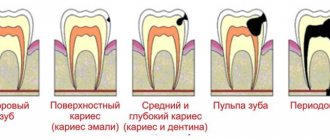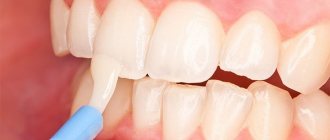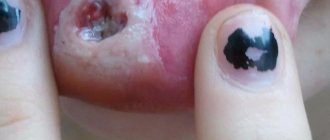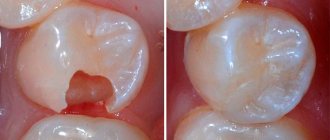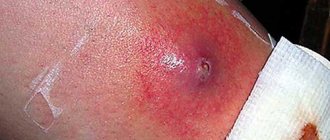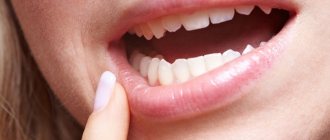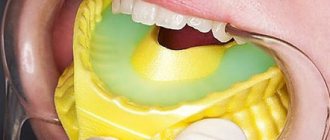9756
Pulpitis is the most common disease, the symptoms of which are severe pain in the teeth. It is also the most common complication of dental caries. When it appears in the tooth pulp, an inflammatory process occurs and spreads, which manifests itself in the form of painful sensations.
It is very difficult to cope with this disease on your own, because the inflammation is localized in the pulp (the soft inner part of the tooth) and can continue to spread.
general information
Photo: pulpitis in aggravated form
There are many “home” folk treatment methods that allow you to avoid a trip to the dentist or, at least, delay it quite a lot. Traditional methods make it possible to stop the spread of inflammation and prevent infection from spreading to other areas, which is very important for preventing many inflammations of pulpitis.
All self-treatment methods help reduce inflammation and provide antimicrobial therapy, help get rid of swelling and pain
. The basis of all methods is natural remedies - some fruits, vegetables, as well as medicinal herbs.
You can also use available medications sold at pharmacies to provide first aid. After all, sometimes the first thing you need to do is relieve severe pain.
As effective methods of exposure, home treatment includes the following procedures:
- mouth rinses;
- irrigation;
- rubbing the medicine into the gum mucosa in the area where inflammation is localized;
- lotions and compresses;
- tampons;
- baths.
It is also worth mentioning that all folk remedies that are made from plants can have a completely individual effect and are perceived differently by the body.
That is why a remedy that is effective in one case may be practically useless in another. They should be used with caution, taking into account the characteristics of each patient’s body.
How to properly treat pulpitis at home
Pulpitis is the name given to chronic or acute inflammation and decay of the soft tissues of teeth. The disease develops in a confined space and is accompanied by severe pain. The cause is untreated deep caries. If treatment does not occur, you may lose your tooth. Curing such inflammation on your own is a difficult task; dentists have a negative attitude towards such attempts. Home methods can alleviate a person’s condition before going to the doctor.
Traditional methods can be used exclusively as auxiliary measures if it is not possible to immediately go to a dentist. There are only three days for self-treatment. Otherwise, there is a risk of getting phlegmon or blood poisoning.
Ambulance
There are several ways to significantly reduce the intensity of pain due to pulpitis, as well as get rid of it. They consist in the use of traditional medicines, freely sold in pharmacies.
Anti-inflammatory nonsteroidal drugs
These remedies relieve pain
, at the same time
reducing possible swelling and lowering the temperature
if it was elevated. This action is associated with the influence of drugs on the components of the ongoing inflammatory process.
Of the entire group of these drugs, there are some that are used in this case. They are quite effective and have low toxicity.
Here is their list:
- ibuprofen;
- ketorol,
- ibuklin,
- voltaren,
- indomethacin,
- lornoxicam,
- etodolac,
- meloxicam,
- nimesulide,
- Viox,
- Celebrex,
- nabumethon,
- tenoxicam.
Usually the maximum dose per day is no more than three tablets
, however, this depends on the dosage in each case.
Let us understand in detail what tooth pulpitis is and for what reasons it may appear.
This article explains the best way to treat gum disease.
Here: https://www.vash-dentist.ru/lechenie/zubyi/lz-mudrosti/bolit-chto-delat-v-takom-sluchae.html - you will find out what to do if your wisdom tooth hurts.
Finlepsin
Refers to antiepileptic drugs. This drug has a fairly strong analgesic effect.
, so it is also used for toothache. After taking it, your mood also improves.
However, the drug slows reaction time and may cause drowsiness
. It should be taken with caution by people who work with machinery or anything else that requires full concentration.
Local anesthesia
If the patient knows that he is not allergic to the components of these drugs, then topical agents can also be used for pain relief. The bulk of them are produced in the form of gels and sprays.
Gels are simply applied to the gum in the area of the diseased tooth: Dentinox, Cholisal, Kalgel, Pansoral
.
And the sprays contain quite strong anesthetics - lidocaine, dicaine, ultracaine
.
Clove oil
This remedy is traditionally used in dental practice as a natural pain reliever.
. If pulpitis occurs in the tooth where the filling is located, then the oil is simply applied to the gum. If there is an open carious cavity, then a drop of oil is placed directly into it.
Rinse
The most popular and simple procedure used for home treatment of pulpitis is rinsing. With their help, you can not only reduce pain and get rid of it, but also relieve swelling, reduce inflammation and remove most of the pathogens that cause the disease.
It is very important that the liquid prepared for rinsing is at a comfortable temperature, a little more than room temperature - barely warm. Hot rinses are harmful in this case, since they have a beneficial effect on bacteria and promote even greater growth.
For rinsing, decoctions and tinctures of various medicinal plants, as well as solutions of soda and peroxide and various alcohol infusions can be used.
Sage
You should prepare a decoction of two to three tablespoons of the dry plant and let it cool. The decoction is concentrated, so immediately before the procedure it should be diluted with warm boiled water.
.
Rinse should be done daily
. If possible, then every hour and a half, but no less than once every two to three hours.
Sage is an excellent remedy that soothes, reduces pain, discomfort, and also has an antiseptic effect.
willow bark
You need to take two or three tablespoons of crushed dry bark. It is poured with a glass of boiling water. Close the container tightly and wrap it to let it brew and cool. After cooling, strain thoroughly and dilute a little with water.
Rinsing is carried out at intervals of once every few hours. Action: pain relief and reduction of inflammation.
Bay leaf
It is prepared and used in the same way as willow bark - a dozen leaves are poured with boiling water, infused, cooled and filtered. Works well as a disinfectant
, removing pathogens from the oral cavity.
Also relieves swelling
.
Knotweed and elder flowers
Mix dry elderberry and knotweed in a one to one ratio. In a small thermos (350–400 mm), two tablespoons of the resulting mixture are steamed. After cooling and straining, you should rinse with this tincture quite often - every one and a half to two hours. Perfectly relieves even acute pain
.
Pomegranate peel
Take the peel from two pomegranates. It is crushed a little and kept in a water bath for two hours. Rinsing is carried out every 3-4 hours. In addition to relieving pain, swelling and inflammation
, with the help of infusion of pomegranate peel, effective
prevention of pulp suppuration
.
Propolis and calamus
Pain relief and high-quality disinfection that relieves swelling can be carried out using an alcohol tincture of two plants - propolis with calamus. Initially, take an alcoholic infusion of propolis and mix it in equal parts with crushed calamus. The resulting mixture is diluted with lukewarm boiled water.
Rinsing is carried out every few hours every day for a long time (about a month).
Propolis can also be used independently. A small piece is applied tightly to the gum, where the tooth hurts. This helps to quickly get rid of pain.
Hydrogen peroxide
This is the simplest remedy that is available in any home. An aqueous solution is used for rinsing. It not only has a disinfecting effect, but also helps remove bacterial plaque and localize inflammation, preventing its spread.
Soda
Regular baking soda is also used for pulpitis to reduce pain and provide high-quality disinfection. One heaped teaspoon of soda should be diluted in a glass (250 ml) of warm boiled water. This solution should be used to rinse the mouth several times daily – 3–5 times.
What symptoms may indicate the presence of pulpitis?
Before moving on to the analysis of traditional medicine methods that help alleviate the condition of acute pain from pulpitis, you should consider the main symptoms of this disease. Almost always, pulpitis becomes the result of severely advanced caries, in which destructive processes penetrate into the deeper layers of the tooth and reach the pulp. Thus, the obvious signs of pathology include the following phenomena and conditions:
- the pain is localized in a specific place,
- pain occurs at regular intervals,
- the pain gets worse at night,
- Increased sensitivity of the enamel occurs - acute pain appears upon contact with hot or cold food or drinks, or when pressing on the tooth.
The photo shows tooth pulpitis
“About a year ago, I had a terrible toothache at night. In general, he had a filling on him, as he had previously treated caries. But less than a few months later, pain in a recently healed tooth took me by surprise. Rinsing with ginger and a small amount of soda helped me a lot then. It all happened at the dacha, and as luck would have it, there wasn’t even a painkiller! But this folk remedy really saved me; my neighbor at the dacha suggested it. By evening I was already in the city and ran to the dentist. By the way, I had to remove the seal, clean everything there again and put a new one.”
Margarita P., 35 years old, from correspondence on a thematic forum
In the chronic form of the disease, the pain may subside and become aching. In this case, there may be no pain at all, since at this stage the bacteria have already managed to completely “kill” the pulp1. Chronic pulpitis occurs as a result of prolonged ignoring of unpleasant obvious symptoms, as well as due to improper self-medication.
Rubs, lotions and other recipes
In addition to the rinses that are popular in the treatment of pulpitis at home, they also use other remedies that can be easily prepared independently using medicinal plants and other herbal ingredients.
How are the procedures carried out?
The variety of procedures is quite large, so you should tell us how to carry them out correctly.
- Baths for the oral cavity
. The liquid is taken into the mouth in quite a large amount and should be held for a while without swallowing or spitting. Any tinctures, mixtures and decoctions that are used for rinsing can also be used for baths. Moreover, these two procedures can be combined and alternated. - Compresses and lotions
. A gauze pad (possibly a cotton pad) is soaked in the medicinal decoction/infusion, then wrung out lightly. It needs to be applied to the gum, which is located under the problem tooth, and held for several minutes. This procedure should be performed three to five times every day until the inflammation goes away. - Rubbing
. First of all, a cream or paste is prepared using natural ingredients. A small amount of the prepared “ointment” is applied to the gums and rubbed in without pressure and with light movements until completely absorbed. This method should not be overused, as it can cause irritation of the gum mucosa. It will be enough to achieve the effect if you rub it three times a day.
We invite you to look at photos of cervical caries and learn about methods of combating this disease.
In our article you can find out the prices for Sensodyne toothpaste.
At this address: https://www.vash-dentist.ru/lechenie/zubyi/gnilyie-prichinyi-i-foto.html - you will find photos of rotten teeth in children and learn how to deal with it.
What is used for lotions and rubbing?
- Salo
. Used as a pain reliever. A small piece of fresh pork lard is placed directly on the formed carious cavity, pressing slightly. It should be held until the pain stops. - Coniferous resin
. You should keep a small piece of resin from coniferous trees near the gum of the diseased tooth until it is completely dissolved. This is a good disinfectant that can stop inflammation. - Ginger
. Removes inflammation due to its beneficial effect on blood supply and nutrition of the pulp. About 20 g of fresh ginger is brewed with a glass of boiling water, then a teaspoon of soda is added. - Garlic
. Natural very strong antiseptic. Several times a day, its juice should be rubbed into the gums.
Pulpitis is a rather dangerous disease with which you need to be very careful. If possible, it is advisable to consult a professional dentist about the traditional methods used.
And a few more folk recipes for treating pulpitis await you in the following video:
If you find an error, please select a piece of text and press Ctrl+Enter.
Tags at home treatment of pulpitis
Did you like the article? stay tuned
Previous article
Mouth guard for bruxism: description, types, cost
Next article
Trema between teeth: causes, types, treatment


